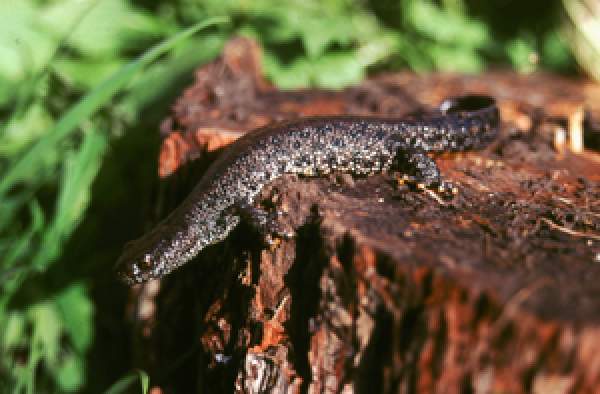Great Crested Newt
Triturus cristatus

While male Great Crested Newts can reach 15cm in length, the larger females have been recorded reaching 18cm in length. The skin has a dark warty structure, with a scatter of white spots along the side of the body, and this gives rise to its other name 'Warty Newt'. The underside is brilliantly coloured with yellow or orange, mixed with an irregular pattern of darker spots.
This pattern is as individual to each newt as a fingerprint. The characteristic crest of the male, which runs from the back of the head to the base of the tail, is only present during the breeding season. A separate 'spear-shaped' crest also develops on the tail and this has a stroke of white running along each side.
Like other newts, the Great Crested Newt occupies a range of habitats and can regularly be found 500m or so from favoured breeding ponds. It is the most aquatic of our three newt species and can typically be found in the breeding ponds from March through into July. It is also the most nocturnal of our newts.
During its terrestrial existence, the species will hunt for a range of invertebrate prey. Arrival at the breeding ponds takes place at night, with the males seemingly arriving a few days before the females. The Great Crested Newt prefers to use the bottom part of the pond, rising to the surface periodically to take a gulp of air.
Great Crested Newts are eaten by birds, fish, mammals and reptiles such as the Grass Snake.
Loss of habitat and suitable breeding ponds has been responsible for a long-term decline in this species. Although widespread, populations are thought to still be in decline at all but the best quality sites. Due to this, the Great Crested Newt is a Priority Species in the UK Biodiversity Action Plan, is protected under law and listed in the EU Species Directive.
The range of prey taken while in the pond reflects the bottom-dwelling lifestyle, with leeches and water beetles featuring quite heavily. Larger prey items, including young Smooth Newts and adult dragonflies may be taken very occasionally. Courtship is a highly evolved affair, with the male engaging in an elaborate courtship display prior to mating. Courtship is usually over by June but instead of leaving the pond, the newts will remain to feed on the abundance of food that summer provides.






Share this page